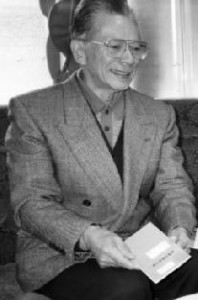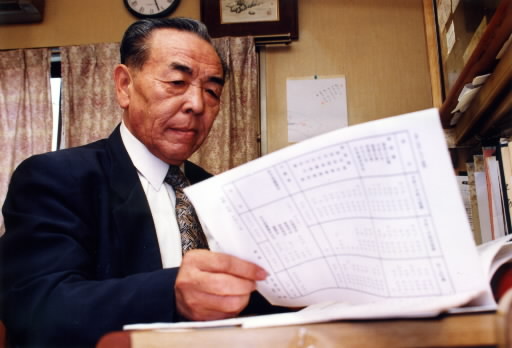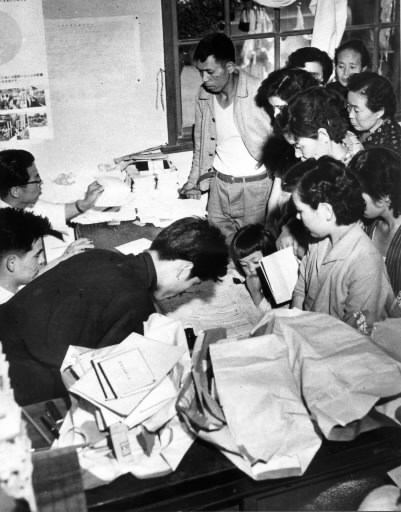History of Hiroshima: 1945-1995 (Part 8, Article 1)
Aug. 1, 2012
Atomic Bomb Survivor’s Certificate
by Yoshifumi Fukushima, Staff Writer
Note: This article was originally published in 1995.
The crowd of A-bomb survivors gaze intently at the hands of the person in charge, which hold an Atomic Bomb Survivor’s Certificate. The photo captures the feelings of the survivors toward the small postcard-sized document. Thirty-eight years ago, the Chugoku Shimbun reported that, following the implementation of the Atomic Bomb Medical Relief Law, the certificate was granted to “1,850 survivors in the city of Hiroshima” on the first day it was issued.
For A-bomb survivors, still suffering from the aftereffects of the bomb’s heat rays and radiation, the Atomic Bomb Medical Relief Law was gained only after emotional appeals for legislation that would provide relief measures to the survivors. Though the law did not fill the void concerning “compensation for the dead,” the Atomic Bomb Medical Relief Law and the subsequent A-bomb Survivors Special Measures Law, which together formed the “Two Atomic Bomb-Related Laws,” gradually opened the door to relief measures involving the medical care and welfare of A-bomb survivors. In July of this year, the Atomic Bomb Survivors Relief Law, an integration of the two laws, will take effect.
Filling the gap left by local governments are independent volunteer activities and other support efforts, which include visits to hospitals to bring cheer to hospitalized survivors.
Fifty years after the atomic bombing, there are A-bomb survivors still seeking the Atomic Bomb Survivor’s Certificate, which began being issued under an ardent gaze. Through applications for the certificate filed many years afterward, as well as a look at the background behind activities providing assistance for obtaining the certificate, a glimpse into the hidden lives of A-bomb survivors can be seen.
Takeshi Takeuchi helps A-bomb survivors locate witnesses
Their hair fell out and blood seeped from their gums. Purple spots broke out on their bodies. The accounts of acute symptoms suffered by A-bomb survivors had begun to circulate. One woman’s husband was among those who experienced the bombing in Hiroshima. “Is he all right?” she wondered. Shortly after the war ended, the wife went to her husband, still just newlyweds, and tugged gently on his hair as he lay sleeping.
The couple is Tsuneo Shimazu, now 74, and his wife Katsue, 73, residents of the city of Gotsu in Shimane Prefecture. At his wife’s urging, Mr. Shimazu, who had never talked about the atomic bombing with her before then, began the application procedure to obtain the Atomic Bomb Survivor’s Certificate some 20 years after the war. “But I had no one who could serve as a witness for my A-bomb experience,” Mr. Shimazu said.
Handouts distributed to the press at the City Hall Press Club contained the names of three A-bomb survivors, including Mr. Shimazu. At this venue, located on the third floor of the former Hiroshima City Hall building, Takeshi Takeuchi, 67, a member of the Hiroshima Prefectural Confederation of A-bomb Sufferers Organizations and a resident of Nishi Ward, Hiroshima, appealed: “These survivors have no witnesses to enable them to apply for the Atomic Bomb Survivor’s Certificate. We would appreciate your help in searching for witnesses.” It was July of 1972 and the first campaign to find witnesses to the A-bomb experience was being launched by the Hiroshima Prefectural Confederation of A-bomb Sufferers Organizations so that survivors could obtain the certificate, which provided “proof” of their exposure to the atomic bomb.
Four years had passed since the A-bomb Survivors Special Measures Law was implemented in 1968, following passage of the Atomic Bomb Medical Relief Law in 1957. As the years went by, it was becoming increasingly difficult to locate at least two witnesses as required to obtain the Atomic Bomb Survivor’s Certificate.
“Naturally, the Atomic Bomb Medical Relief Law, the first A-bomb-related law, gave us great satisfaction,” said Mr. Takeuchi, expressing his frank appreciation for this development. The law enabled A-bomb survivors to obtain the Atomic Bomb Survivor’s Certificate and paved the way for the provision of medical benefits, including free health checkups and free medical treatment to A-bomb survivors. The government, which had been slow to act, finally moved forward on this legislation after A-bomb survivors and others made emotional appeals and the death of Aikichi Kuboyama, who was exposed to radioactive fallout from a U.S. hydrogen bomb test while aboard the Japanese tuna fishing boat “Daigo Fukuryu Maru,” raised awareness among the public of the horrors of radiation.
In the beginning, the Atomic Bomb Survivor’s Certificate was provided as soon as an application was made. Proving that the applicant had experienced the bombing was not a troublesome task. The screening process, as well, was straightforward. From around 1965, though, Mr. Takeuchi began to receive letters asking him for help in locating witnesses. One of these letters came from Mr. Shimazu, who made his request through a teachers’ organization.
Speaking at his home, located a short distance from the Gonokawa River, the largest river in the Chugoku Region, Mr. Shimazu said: “I was in Hiroshima for just four days when I suffered the atomic bombing.” Previously a teacher at a national school, he had enrolled in the corps of engineers in Hiroshima. While he was waiting for redeployment at Hakushima Elementary School, the atomic bomb fell.
Mr. Shimazu survived the blast without injury, as he was inside the building. But he was exposed to the black rain and saw mounds of bodies beside the Ota River. However, as he was largely unfamiliar with the city of Hiroshima, it was impossible for him to remember the layout of the Hakushima area and the geography of the city as a whole. He could not even be certain of the name of his corps commander. And the key document of his claim, the statement of his service in the Hiroshima corps, no longer existed because the building of the Shimane Prefectural Government burned down in the winter of 1956.
Katsue, Mr. Shimazu’s wife, was more enthusiastic about applying for the Atomic Bomb Survivor’s Certificate. Their neighbors, an elderly married couple who had survived the bombing, recommended to her repeatedly: “As the months pass, it will become more difficult to get the certificate. You should apply as soon as possible.” Mr. Shimazu, however, who had not even shared the details of his A-bomb experience with his family, was reluctant.
“Above all, I was afraid that it might affect my daughters’ future, like their chances of getting married,” Mr. Shimazu said. “Besides, I was fine back then, fortunately.” With these uneasy feelings, he did not dare disclose that he was an “A-bomb survivor.” He was also aware that his daughters were expressing concern, saying, “Are we second-generation A-bomb survivors? Are we all right?”
Around that time, an article seeking advice on exposure to the atomic bombing appeared in the newspaper. Katsue responded with a letter, which later led to an effort to locate witnesses for her husband. Katsue’s thoughtfulness, along with the wedding of his eldest daughter, soon made Mr. Shimazu take the situation more seriously. After Mr. Shimazu disclosed that he was an A-bomb survivor, he obtained substantial information about his past. But the information did not easily tally with his memories. Because he was afraid of filing a “false application,” he dutifully waited for witnesses to appear. Five months after revealing his status as a survivor, he finally found someone from the corps of engineers, a person with whom he had fled, and he proceeded to file his application for the certificate.
Today, Mr. Shimazu receives a survivor’s health care allowance for an eye ailment. However, for the seven years from the time he acquired the certificate to the time of his retirement, he used it when undergoing health checkups but not for other purposes. “The certificate is helpful, but behind it is the history of my survival involving life and death,” he said. He did not want to use the certificate lightly.
Mr. Takeuchi, who singlehandedly undertook the task of seeking witnesses for A-bomb survivors, including Mr. Shimazu, has continued to provide advice, wanting to “serve as a source of emotional support for the survivors.” At the same time, Mr. Takeuchi himself is challenged by a physical disability.
One month after he was born, he contracted polio. His left leg is thin and five centimeters shorter than his right leg. When he was a child, he would often get pushed and thrown to the ground by other children, and returned home in tears. Such experiences stirred a mix of frustration and resentment inside him. Then, he fell victim to the atomic bomb. At the time, Mr. Takeuchi worked for a post office in the Koi area. He was uninjured in the blast and, despite his disability, was able to rescue a junior high school student from a sea of fire. Several days later, however, the student passed away.
“I’ve never known a time when my leg was normal,” Mr. Takeuchi said. “A-bomb survivors are distressed all the more by their ailments because they can recall a time when their health was good. Those who become burdened by disability later in life experience greater suffering. Compared to them, I’m on the happier side of the scale.” With this attitude, Mr. Takeuchi has given himself to the support of A-bomb survivors.
Until he officially retired two years ago from his role as a consultant for A-bomb survivors, Mr. Takeuchi had been engaged in efforts to locate witnesses for 815 survivors over a span of 22 years. However, the total number of those who consulted with him, including people whose identities were not formally disclosed, exceeds 5,000. In each case, Mr. Takeuchi would make a painstaking search for witnesses by visiting veterans’ societies, schools, workplaces, and other locations. As the years passed, requests for witnesses shifted from those who experienced the atomic bombing directly to those who were exposed to the atomic bomb’s residual radiation when they entered the city in the aftermath of the blast. For this reason, it grew more difficult to find witnesses, but Mr. Takeuchi’s persistent inquiries led to the issuing of the certificate for almost all those who asked for his assistance.
Mr. Takeuchi believes the main factors keeping some A-bomb survivors from seeking the certificate to this day are society’s “ignorance” and “prejudice.” A-bomb survivors hold deep-seated fears that they will become the brunt of wrongful prejudice, particularly in prefectures located far from the A-bombed city. However, he always tells those who consult with him: “If you want to hide the fact that you’re an A-bomb survivor, it would be better not to get the certificate. But that would be a mistake. The fact that you were exposed to radiation due to the atomic bombing is a serious matter. First, get the certificate. Then, if you don’t want to use it, don’t use it.”
Mr. Takeuchi is convinced that, since the law was created with considerable effort, “it will lose its meaning if people don’t make the most of it.” When those he has assisted report to him that they have obtained the certificate, he never fails to advise them to “make the most of it by studying the law and living a long life.”
He has also seen the harmful repercussions of false claims for the certificate. One survivor experienced the atomic bombing at Hiroshima Station, but had no witnesses to verify that fact. Instead, this person claimed to have entered the city on a different day and then was able to obtain the certificate. But when the survivor’s child, who experienced the atomic bombing together with the parent, later applied for the certificate, the child’s application was rejected on the grounds that “the child’s testimony contradicted that of the parent.”
“Don’t go so far as to falsify the facts in order to obtain the certificate,” Mr. Takeuchi said. “The local governments that receive the applications will believe that the testimony made by an earlier applicant is the true account. We must not breed lies.” At the very least, the facts of the atomic bombing must be accurate.
Mr. Takeuchi stepped down from his formal role as a consultant for A-bomb survivors to take care of his wife, who has become partially disabled. Still, the telephone at his home continues to ring, asking for his advice. He also sends New Year’s cards with words of guidance to those he has assisted. When Mr. Takeuchi hears about the death of a certificate holder, he writes a letter to the bereaved family and asks, “Did you have the holder’s name put in the register in the Cenotaph for the A-bomb Victims?”
The Atomic Bomb Medical Relief Law articulates its aims in this way: “In light of the unique health conditions of the A-bomb survivors, which have persisted...” But even when survivors are granted the certificate in line with the law, they will not be covered by medical benefits unless they are suffering from illness. “Moreover,” thinks Mr. Takeuchi, “there is no restitution of any kind for those who died in the atomic bombing, even though they were hit hardest of all.” This thought has lingered in the back of his mind and troubled him. He wonders: “Isn’t there some kind of ‘certificate’ that can help compensate the dead?”
Article in the Chugoku Shimbun on October 15, 1963
The Atomic Bomb Medical Relief Law, enacted in 1957, was a measure long sought for A-bomb survivors, who had been receiving no medical assistance. The system put in place, which was established three years later in conjunction with the law’s revision, permitted certain “special” survivors, such as those who experienced the atomic bombing from a close proximity, to receive medical benefits even for illnesses other than designated A-bomb diseases. Year after year, the number of those covered by the system increased. At the same time, there were also growing calls for eliminating the differences in benefits between the “special” A-bomb survivors and the general population of A-bomb survivors. Below are excerpts from a letter that was sent to the Chugoku Shimbun from a housewife who was ill in bed. She had appealed for the differences in benefits to be resolved. This disparity was eliminated in 1974, 11 years after the letter arrived.
-----------------------------------------------------------------------------------------------------------------------
I wonder what sort of response a great number of sick A-bomb survivors holding the general certificate, like me, receive during medical examinations at large national, prefectural, municipal, and public hospitals. I hear every doctor say the same thing: “I understand you’ve been suffering badly from illness since you lost your health that day. But under this system, it isn’t so easy to switch your certificate to the special certificate. Frankly speaking, we’re not supposed to give permission for such a switch unless your health progressively deteriorates to an acute state.” Such responses leave me feeling so wretched and disgusted that I’m unable to shed tears. It is now widely known that the early detection and treatment of health problems is the best remedy. Who in the world would let their condition deteriorate and risk their life, just to get the special certificate? In these circumstances, those holding the general certificate are basically forced to cry themselves to sleep in a valley that lies out of the reach of relief measures for A-bomb survivors.
For a long time, right up to today, the delicate state of our health has kept us trapped in a vicious and endless cycle of illness and poverty. I hope that a strong effort will be made to abolish, as soon as possible, the discrimination inherent in the framework of the Atomic Bomb Medical Relief Law. I eagerly look forward to that day.
(Originally published on March 12, 1995)










